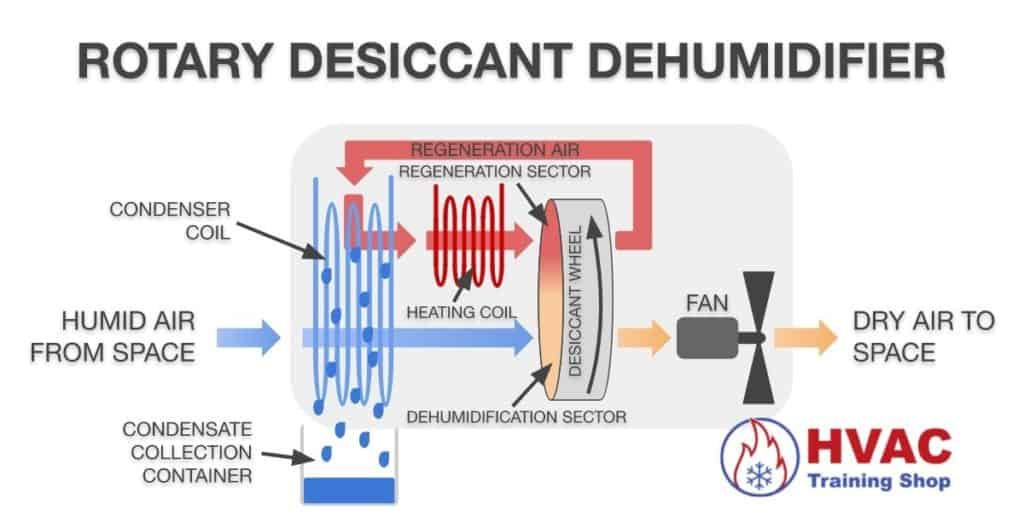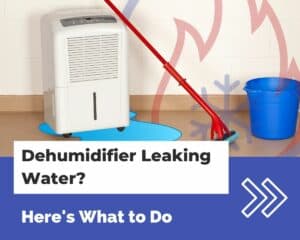If you’re looking to remove moisture from your home, then a desiccant dehumidifier offers certain advantages that compressor dehumidifiers do not.
Most notably, desiccant dehumidifiers are able to bring the humidity down to a much lower level than compressor dehumidifiers. They are also able to work in much colder temperatures.
However, desiccant dehumidifiers are complicated machines. There are many different types out there. Depending on the type of you need to dehumidify, one type of desiccant dehumidifier will work better than another.
In this article, I’ll go over how desiccant dehumidifiers work. I’ll also discuss the different types of desiccant dehumidifiers and the pros and cons of desiccant dehumidifiers.
How does a desiccant dehumidifier work?
Desiccant dehumidifiers work by absorbing moisture from the air using a chemical mixture.
Most desiccant dehumidifiers utilize a rotary wheel embedded with a desiccant mixture. As the wheel spins around, moist air is blown through one side of the wheel to remove moisture from the air.
On the other side of the wheel, hot air is blown through the wheel to remove moisture from the wheel. The hot air is called “reactivation air” since it reactivates the desiccant by removing moisture from the wheel.
The dehumidification and reactivation process happens continuously while the desiccant dehumidifier is on.
But what happens to the moist reactivation air? The reactivation air will either be dried out with a condenser coil or removed from the building completely—depending on the type of desiccant dehumidifier.
Types of desiccant dehumidifiers
Desiccant dehumidifiers can take on many forms. They are also found in all sorts of places—from small pods that you can stick in your closet to large machines that go in commercial buildings.
Below I’ll go over a few different types of desiccant dehumidifiers:
Rotary desiccant dehumidifiers
Rotary desiccant dehumidifiers are self-contained, all-in-one dehumidifiers. They work by blowing air through a wheel made of desiccant.
As the air flows through one side of the wheel, the desiccant wheel sucks the moisture out of the air.
On the other side of the wheel, “reactivation air” flows through a heating coil and then passes through the wheel to remove the moisture.
After removing moisture from the wheel, the air flows through a cool condenser coil. In the condenser coil, the moisture condenses out of the reactivation air and collects in a tank for disposal.
If you’ve ever seen a small, portable desiccant dehumidifier on wheels then it was most likely a rotary desiccant dehumidifier.

Commercial and industrial rotary desiccant dehumidifiers
The large desiccant dehumidifiers that you find in commercial and industrial buildings work a bit differently than the ones you find in a home.
The main difference is how they treat the reactivation air. Instead of flowing through a cool condenser coil, the reactivation air is exhausted directly outside.
The reactivation air is blown outside since it’s more energy-efficient than condensing the moisture into a collection tank.
There is also the advantage of using heat from other systems to heat up the reactivation air. Treating reactivation air with natural gas or waste heat is much cheaper than using electric refrigeration.
Disposable desiccant dehumidifiers
Have you ever gotten a small plastic pack inside your food that says “DO NOT EAT”? That is a disposable desiccant dehumidifier!
Disposable desiccant dehumidifiers are also known as “moisture absorbers”. This type of dehumidifier is basically a pack of moisture-absorbent chemical material. The pack is placed in a humid area to absorb moisture, such as a closet or cabinet (or a bag of potato chips!)
The main drawback of using a disposable desiccant dehumidifier is that it can only be used one time. After it absorbs a certain level of moisture, it is no longer useful and needs to be thrown away.
Rechargeable desiccant dehumidifiers
Rechargeable desiccant dehumidifiers are basically the same as the disposable type—except they can be used over and over again. Once a rechargeable desiccant dehumidifier absorbs a certain level of moisture, it can be “reactivated” by heating it up.
In fact, I use rechargeable desiccant dehumidifiers in my toolboxes to prevent my tools from getting rusted. Every few months, I put the rechargeable desiccant dehumidifier packs in my oven for a couple of hours to recharge them.
Some rechargeable desiccant dehumidifiers come with a heating element built-in to them, so you can just plug it in for a few hours to recharge it.
Desiccant dehumidifier pros and cons
The main advantage of using a desiccant dehumidifier is that it is able to bring your room’s air to a lower humidity level than a compressor dehumidifier can.
I’ll explain by comparing the working principles of a compressor versus a desiccant dehumidifier:
Compressor dehumidifiers rely on squeezing the moisture out of the air by bringing the air’s temperature lower than its dew point. The drawback of this method is that there is a limit to how much moisture can be removed from the air.
Think of the air like a wet rag. If you try to squeeze water out of the wet rag, it will still be damp no matter how hard you squeeze.
Desiccant dehumidifiers work by a completely different principle. Desiccant dehumidifiers utilize a moisture-absorbent material. So as long as there is any bit of moisture in the air, a desiccant dehumidifier is able to suck it out.
Another advantage of using a desiccant dehumidifier is that it works in low temperatures. Most desiccant dehumidifiers work at freezing temperatures down to 32°F. Compressor dehumidifiers can only effectively remove moisture from the air above 60°F.
Desiccant Dehumidifier Pros and Cons | |
Pros | Cons |
|
|



